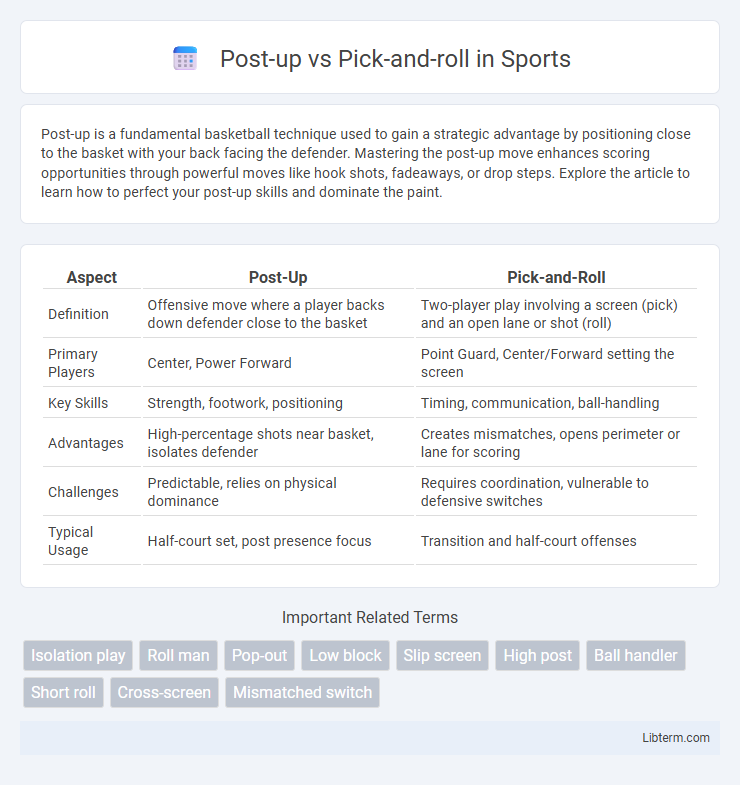Post-up is a fundamental basketball technique used to gain a strategic advantage by positioning close to the basket with your back facing the defender. Mastering the post-up move enhances scoring opportunities through powerful moves like hook shots, fadeaways, or drop steps. Explore the article to learn how to perfect your post-up skills and dominate the paint.
Table of Comparison
| Aspect | Post-Up | Pick-and-Roll |
|---|---|---|
| Definition | Offensive move where a player backs down defender close to the basket | Two-player play involving a screen (pick) and an open lane or shot (roll) |
| Primary Players | Center, Power Forward | Point Guard, Center/Forward setting the screen |
| Key Skills | Strength, footwork, positioning | Timing, communication, ball-handling |
| Advantages | High-percentage shots near basket, isolates defender | Creates mismatches, opens perimeter or lane for scoring |
| Challenges | Predictable, relies on physical dominance | Requires coordination, vulnerable to defensive switches |
| Typical Usage | Half-court set, post presence focus | Transition and half-court offenses |
Understanding Post-up and Pick-and-Roll Plays
Post-up plays involve a player positioning near the low block or elbow to receive the ball with their back to the basket, using strength and footwork to create scoring opportunities against defenders. Pick-and-roll plays feature a ball-handler using a screen set by a teammate, allowing for quick ball movement and options to shoot, pass, or drive to the basket. Mastery of spacing, timing, and decision-making in both post-up and pick-and-roll situations enhances offensive efficiency and scoring potential in basketball.
Key Differences Between Post-up and Pick-and-Roll
Post-up involves a player establishing position near the basket to receive the ball and score through close-range moves, emphasizing individual strength and footwork. The pick-and-roll consists of a ball-handler using a screen set by a teammate to create mismatches and open passing lanes, prioritizing team coordination and quick decision-making. Key differences include the post-up's isolation focus and low-post positioning versus the pick-and-roll's dynamic screening action and constant player movement.
Historical Evolution of Post-up and Pick-and-Roll
The post-up and pick-and-roll originated from early basketball strategies emphasizing physicality and court spacing, respectively. The post-up gained prominence in the mid-20th century through dominant centers like Bill Russell, who leveraged size and positioning near the basket. The pick-and-roll evolved from 1940s playground styles into a fundamental offensive play, refined by players like John Stockton and Karl Malone to create dynamic scoring opportunities through screens and ball movement.
Player Roles in Post-up vs Pick-and-Roll Scenarios
In post-up scenarios, the offensive player's role centers on establishing deep position near the basket to leverage strength and footwork for scoring or drawing fouls, often forcing defenders into close-quarters defense. In pick-and-roll situations, the ball-handler initiates play by using the screen set by a teammate, typically a big man, who then either rolls to the basket or pops out for a shot, requiring precise timing and decision-making. Defensive players must adjust, with post defenders focusing on denying entry passes and pick-and-roll defenders communicating switches or hedging to contain both the ball-handler and the screener effectively.
Offensive Benefits of Post-up Plays
Post-up plays empower offensive players to exploit their size and strength advantages near the basket, creating high-percentage scoring opportunities through close-range shots and layups. This strategy allows skilled post players to draw multiple defenders, opening perimeter options for teammates and enhancing overall floor spacing. Utilizing post-up techniques effectively increases offensive efficiency by leveraging positioning and physicality to control momentum in the paint.
Offensive Advantages of Pick-and-Roll Strategies
Pick-and-roll strategies create dynamic offensive opportunities by forcing defenders into difficult decisions, often leading to mismatches or open shots. This tactic enhances ball movement and player spacing, allowing for efficient scoring options such as drives, mid-range jumpers, or kick-out three-pointers. Teams employing pick-and-roll effectively maximize their ball-handler's decision-making and capitalize on defensive rotations to generate high-percentage scoring chances.
Defensive Challenges Against Post-up and Pick-and-Roll
Defensive challenges against the post-up involve containing powerful players with strong positioning and footwork to prevent easy scoring near the basket, often requiring fronting, double-teaming, or help defense rotations. In contrast, defending the pick-and-roll demands quick communication, switching, or hedging to disrupt ball handlers and screeners while maintaining perimeter coverage to prevent open shots or driving lanes. Effective defenses must balance physicality in the post with agility against the dynamic pick-and-roll actions to reduce high-percentage scoring opportunities.
Impact on Team Spacing and Floor Dynamics
Post-up play anchors offense near the basket, attracting multiple defenders and compressing team spacing, which can limit perimeter shooting opportunities but create high-percentage scoring chances and offensive rebounds. The pick-and-roll expands floor dynamics by forcing defenders to navigate screens, creating open lanes and shot opportunities across the court, enhancing spacing and enabling versatile ball movement. Teams leveraging pick-and-roll frequently exploit mismatches and open three-point shots, while post-up strategies emphasize physicality and interior dominance.
Suitability for Different Player Types and Skill Sets
Post-up play suits dominant big men with strong back-to-the-basket skills and physicality, enabling them to seal defenders and create high-percentage shots near the rim. Pick-and-roll excels for versatile guards and forwards who possess quick decision-making, ball-handling, and passing abilities to exploit defensive switches and mismatches. Understanding player strengths and skill sets determines the optimal offensive strategy between these two foundational basketball techniques.
Modern NBA Trends: Decline of Post-up, Rise of Pick-and-Roll
The modern NBA has seen a significant decline in traditional post-up plays, with teams favoring faster, perimeter-oriented strategies that emphasize spacing and three-point shooting. Pick-and-roll usage has surged, now constituting over 30% of offensive possessions league-wide, driven by guard-centers duos exploiting switches and playmaking. Advanced analytics highlight pick-and-roll efficiency, leading franchises to prioritize versatile bigs and sharpshooting guards over dominant post scorers.
Post-up Infographic

 libterm.com
libterm.com